人教版高中英语必修五Book5unit1reading
- 格式:pptx
- 大小:971.75 KB
- 文档页数:41
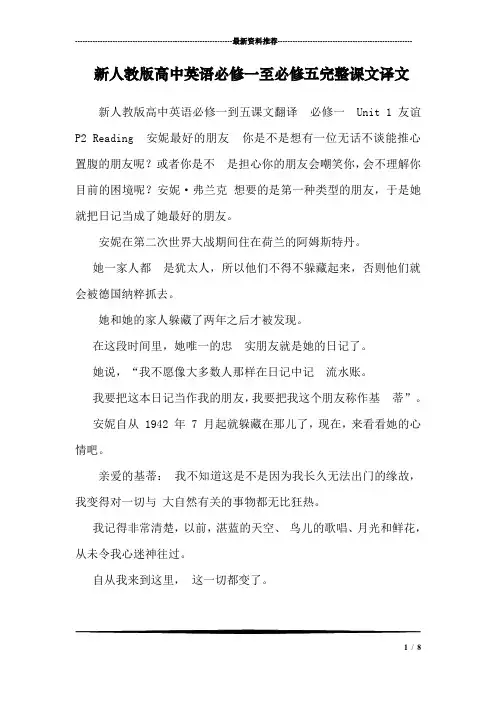
---------------------------------------------------------------最新资料推荐------------------------------------------------------ 新人教版高中英语必修一至必修五完整课文译文新人教版高中英语必修一到五课文翻译必修一 Unit 1 友谊P2 Reading 安妮最好的朋友你是不是想有一位无话不谈能推心置腹的朋友呢?或者你是不是担心你的朋友会嘲笑你,会不理解你目前的困境呢?安妮·弗兰克想要的是第一种类型的朋友,于是她就把日记当成了她最好的朋友。
安妮在第二次世界大战期间住在荷兰的阿姆斯特丹。
她一家人都是犹太人,所以他们不得不躲藏起来,否则他们就会被德国纳粹抓去。
她和她的家人躲藏了两年之后才被发现。
在这段时间里,她唯一的忠实朋友就是她的日记了。
她说,“我不愿像大多数人那样在日记中记流水账。
我要把这本日记当作我的朋友,我要把我这个朋友称作基蒂”。
安妮自从 1942 年 7 月起就躲藏在那儿了,现在,来看看她的心情吧。
亲爱的基蒂:我不知道这是不是因为我长久无法出门的缘故,我变得对一切与大自然有关的事物都无比狂热。
我记得非常清楚,以前,湛蓝的天空、鸟儿的歌唱、月光和鲜花,从未令我心迷神往过。
自从我来到这里,这一切都变了。
1/ 8……比方说,有天晚上天气很暖和,我熬到 11 点半故意不睡觉,为的是独自好好看看月亮。
但是因为月光太亮了,我不敢打开窗户。
还有一次,就在五个月以前的一个晚上,我碰巧在楼上,窗户是开着的。
我一直等到非关窗不可的时候才下楼去。
漆黑的夜晚,风吹雨打,雷电交加,我全然被这种力量镇住了。
这是我一年半以来第一次目睹夜晚…… ……令人伤心的是……我只能透过脏兮兮的窗帘观看大自然,窗帘悬挂在沾满灰尘的窗前,但观看这些已经不再是乐趣,因为大自然是你必须亲身体验的。
P6 Using Language Reading, listening and writing 亲爱的王小姐:我同班上的同学有件麻烦事。
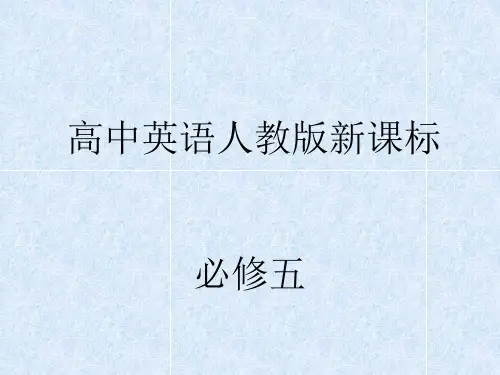

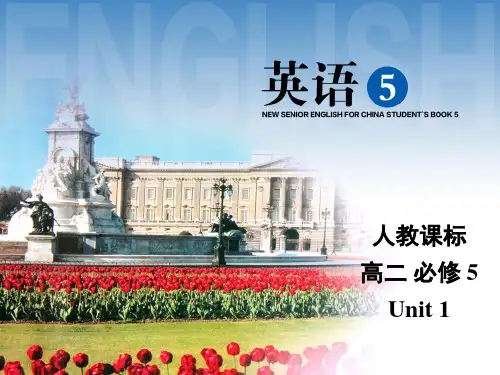
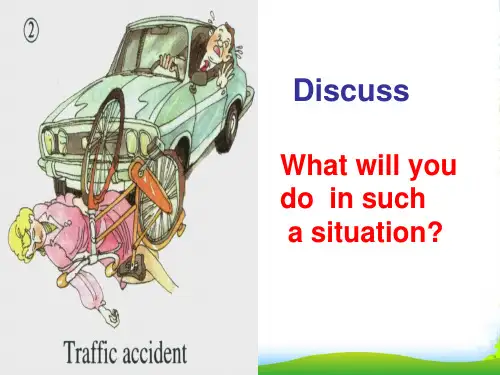
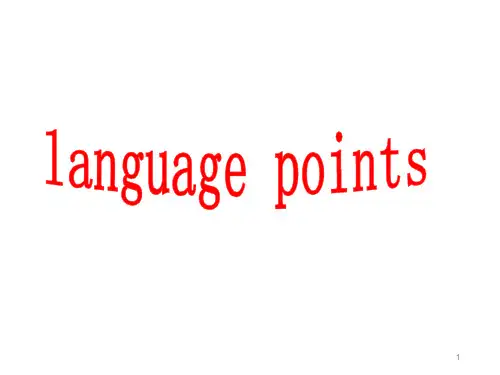
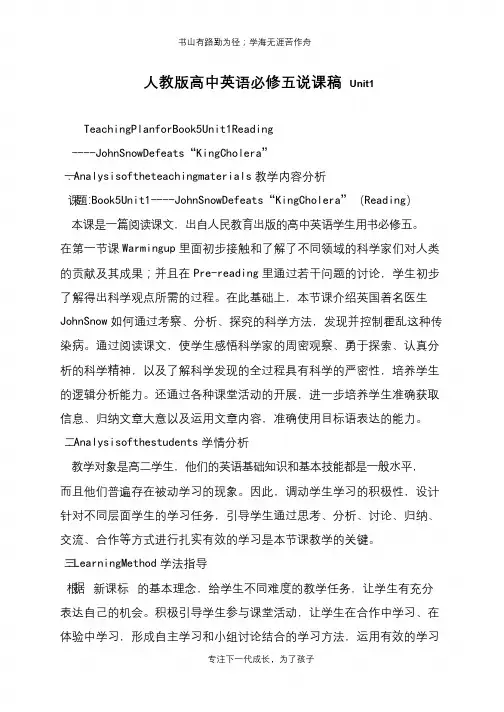
人教版高中英语必修五说课稿Unit1TeachingPlanforBook5Unit1Reading----JohnSnowDefeats“KingCholera”一.Analysisoftheteachingmaterials教学内容分析课题:Book5Unit1----JohnSnowDefeats“KingCholera”(Reading)本课是一篇阅读课文,出自人民教育出版的高中英语学生用书必修五。
在第一节课Warmingup里面初步接触和了解了不同领域的科学家们对人类的贡献及其成果;并且在Pre-reading里通过若干问题的讨论,学生初步了解得出科学观点所需的过程。
在此基础上,本节课介绍英国着名医生JohnSnow如何通过考察、分析、探究的科学方法,发现并控制霍乱这种传染病。
通过阅读课文,使学生感悟科学家的周密观察、勇于探索、认真分析的科学精神,以及了解科学发现的全过程具有科学的严密性,培养学生的逻辑分析能力。
还通过各种课堂活动的开展,进一步培养学生准确获取信息、归纳文章大意以及运用文章内容,准确使用目标语表达的能力。
二.Analysisofthestudents学情分析教学对象是高二学生,他们的英语基础知识和基本技能都是一般水平,而且他们普遍存在被动学习的现象。
因此,调动学生学习的积极性,设计针对不同层面学生的学习任务,引导学生通过思考、分析、讨论、归纳、交流、合作等方式进行扎实有效的学习是本节课教学的关键。
三.LearningMethod学法指导根据新课标的基本理念,给学生不同难度的教学任务,让学生有充分表达自己的机会。
积极引导学生参与课堂活动,让学生在合作中学习、在体验中学习,形成自主学习和小组讨论结合的学习方法,运用有效的学习策略提高学习效率。
合理调动各个层次学生的学习积极性和主动性,从而提高学生的学习兴趣。
四.TeachingAims教学目标AbilityAim1)Totrainthestudents’abilityinskimming&detailedreading.2)Totrainthestudents’abilityofsummarizingapassage. KnowledgeAimToleadthestudentstogetsomeinformationonthestepsofascientificrese archthroughreading.3.EmotionalAim1).Getthestudentstoadaptthescientificspiritintheirpursuitofknowledge.2).Developthestudents’abilityofgroupcooperationandpairwork.五.Teachingimportantanddifficultpoints教学重难点1).Understandthespiritofscienceandscientists.2).Understandthedetailsofeachstageinexamininganewscientificidea.3).Makeupadialogueaccordingtoacertainsituationandthecontentofthi spassage.六.Teachingmethod教学方法1)CommunicativeApproach交际教学法;2)Task-basedApproach任务型语言教学法;3)CooperativeLearningApproach合作学习教学法. 七.TeachingAids教具准备Multi-mediaandtheblackboard八.TeachingProcedures教学过程StepIRevision(2minutes)1)Presentthestudentsaguessinggameforthemtoreviewthegreatscientis tsandtheircontribution.2)Reviewthewaysofdoingascientificresearch.StepIIReading(25minutes)Letthestudentsreadthroughthewholepassageandfinishtherequiredtask andhelpthemtohaveabetterunderstandingofthearticlebyprovidingsome backgroundinformationandanalysis.Task1SkimmingAskthestudentstolookatthetitleandfindout“Who,what”.Thenreadqui cklytofindout“when,where”.Task2DetailedreadingThestudentsarerequiredtofindoutthedetailedinformationaccordingto thestepsofascientificresearch.1)Whatistheproblem?------ Thecholerawasthemostdeadlydiseaseofitsday.Neitheritscause,norits curewasunderstood.2)Makeupaquestion:Whichtheorytobelievein?Idea1:Choleramultipliedintheairwithoutreason.Acloudofdangerousga swouldfloatarounduntilitfounditsvictims.Idea2:Peopleabsorbeditwiththeirmeals.3)Whatmethoddidheuse?-----AmapoftheBroadStreetTeachershouldhelpthestudentstoanalysethemap,Forthemapisthemostva luableclueaboutthecauseofthedisease.4)Analysetheresults----Whathappenedtothepumpwater?5)Collectresults---- ThewaterwasfromtheriverwhichhadbeenpollutedbythedirtywaterfromLo ndon.6)Findsupportingevidence:Whatextraevidencedidhefind?Key:Twootherdeaths.Awomanandherdaughterwholivedfarawaybutdrankth ewateralsodied.7)Drawaconclusionwithcertainty----- Thepollutedwatercarriedthedisease.Task3ComprehendingAskthestudentstonumbertheeventsintheorderthattheyhappenedtohelpt hemrecallthecontentofthepassage.StepIIISummary(7minutes)1)Analysethestyleofthepassage.----Narration2)Summarizethecontentofthepassageusingabout30words.Asksomestudentstopresenttheiranswersandgivethemadvicetocorrectit.T hengiveasampleanswer.StepIVReadingandSpeaking(10minutes)PartA模仿朗读请听课文录音(Paragragh1),并跟读课文,注意语音、语调和停顿。
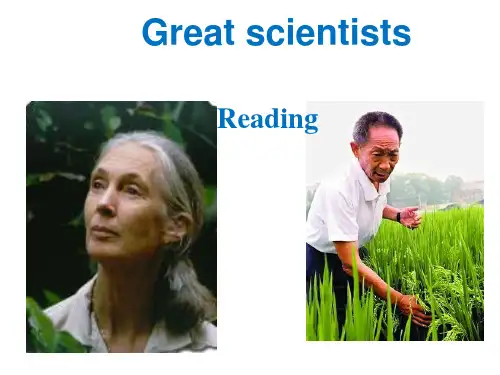
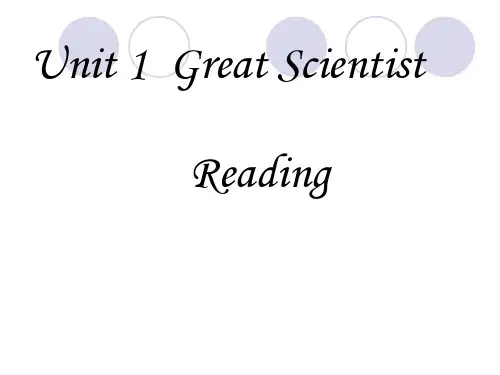
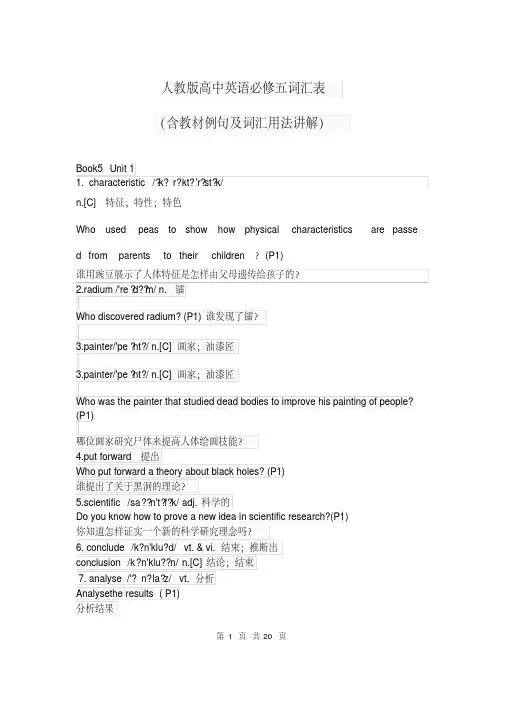
人教版高中英语必修五词汇表(含教材例句及词汇用法讲解)Book5 Unit 11. characteristic /?k?r?kt?'r?st?k/n.[C] 特征;特性;特色Who used peas to show how physical characteristics are passed from parents to their children?(P1)谁用豌豆展示了人体特征是怎样由父母遗传给孩子的?2.radium /'re?d??m/ n. 镭Who discovered radium? (P1) 谁发现了镭?3.painter/'pe?nt?/ n.[C] 画家;油漆匠3.painter/'pe?nt?/ n.[C] 画家;油漆匠Who was the painter that studied dead bodies to improve his painting of people? (P1)哪位画家研究尸体来提高人体绘画技能?4.put forward 提出Who put forward a theory about black holes? (P1)谁提出了关于黑洞的理论?5.scientific /sa??n't?f?k/ adj. 科学的Do you know how to prove a new idea in scientific research?(P1)你知道怎样证实一个新的科学研究理念吗?6. conclude /k?n'klu?d/vt. & vi. 结束;推断出conclusion /k?n'klu??n/ n.[C] 结论;结束7. analyse /'?n?la?z/ vt. 分析Analysethe results ( P1)分析结果第 1 页共 20 页8. △infect /?n'fekt/ vt. 传染;感染△infectious /?n'fek??s/ adj. 传染的What do you know about infectious diseases? (P1)你对传染病了解些什么?9.△cholera /?k?l?r?/n. 霍乱What do you know about cholera? (P1)你对霍乱了解些什么?10. defeat /d?'fi?t/ vt. 打败;战胜;使受挫JOHN SNOW DEFEAT “KINGCHOLERA”(P2)约翰·斯诺战胜“霍乱王”11.expert /'eksp??t/ a dj. 熟练的;经验或知识丰富的(反义词inexpert)John was a famous doctor in London—so expert, indeed, that he attended Queen Victoria as her personal physician. (P2)约翰·斯诺是伦敦一位著名的医生—他的确医术精湛,因而成为照顾维多利亚女王的私人医生。
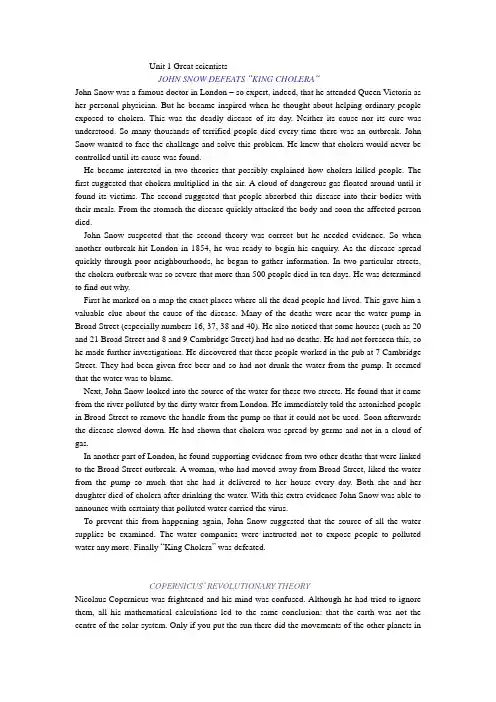
Unit 1 Great scientistsJOHN SNOW DEFEATS “KING CHOLERA”John Snow was a famous doctor in London – so expert, indeed, that he attended Queen Victoria as her personal physician. But he became inspired when he thought about helping ordinary people exposed to cholera. This was the deadly disease of its day. Neither its cause nor its cure was understood. So many thousands of terrified people died every time there was an outbreak. John Snow wanted to face the challenge and solve this problem. He knew that cholera would never be controlled until its cause was found.He became interested in two theories that possibly explained how cholera killed people. The first suggested that cholera multiplied in the air. A cloud of dangerous gas floated around until it found its victims. The second suggested that people absorbed this disease into their bodies with their meals. From the stomach the disease quickly attacked the body and soon the affected person died.John Snow suspected that the second theory was correct but he needed evidence. So when another outbreak hit London in 1854, he was ready to begin his enquiry. As the disease spread quickly through poor neighbourhoods, he began to gather information. In two particular streets, the cholera outbreak was so severe that more than 500 people died in ten days. He was determined to find out why.First he marked on a map the exact places where all the dead people had lived. This gave him a valuable clue about the cause of the disease. Many of the deaths were near the water pump in Broad Street (especially numbers 16, 37, 38 and 40). He also noticed that some houses (such as 20 and 21 Broad Street and 8 and 9 Cambridge Street) had had no deaths. He had not foreseen this, so he made further investigations. He discovered that these people worked in the pub at 7 Cambridge Street. They had been given free beer and so had not drunk the water from the pump. It seemed that the water was to blame.Next, John Snow looked into the source of the water for these two streets. He found that it came from the river polluted by the dirty water from London. He immediately told the astonished people in Broad Street to remove the handle from the pump so that it could not be used. Soon afterwards the disease slowed down. He had shown that cholera was spread by germs and not in a cloud of gas.In another part of London, he found supporting evidence from two other deaths that were linked to the Broad Street outbreak. A woman, who had moved away from Broad Street, liked the water from the pump so much that she had it delivered to her house every day. Both she and her daughter died of cholera after drinking the water. With this extra evidence John Snow was able to announce with certainty that polluted water carried the virus.To prevent this from happening again, John Snow suggested that the source of all the water supplies be examined. The water companies were instructed not to expose people to polluted water any more. Finally “King Cholera” was defeated.COPERNICUS’ REVOLUTIONARY THEORYNicolaus Copernicus was frightened and his mind was confused. Although he had tried to ignore them, all his mathematical calculations led to the same conclusion: that the earth was not the centre of the solar system. Only if you put the sun there did the movements of the other planets inthe sky make sense. Yet he could not tell anyone about his theory as the powerful Christian Church would have punished him for even suggesting such an idea. They believed God had made the world and for that reason the earth was special and must be the centre of the solar system.The problem arose because astronomers had noticed that some planets in the sky seemed to stop, move backward and then go forward in a loop. Others appeared brighter at times and less bright at others. This was very strange if the earth was the centre of the solar system and all planets went round it.Copernicus had thought long and hard about these problems and tried to find an answer. He had collected observations of the stars and used all his mathematical knowledge to explain them, but only his new theory could do that. So between 1510 and 1514 he worked on it, gradually improving his theory until he felt it was complete.In 1514 he showed it privately to his friends. The changes he made to the old theory were revolutionary. He placed a fixed sun at the centre of the solar system with the planets going round it and only the moon still going round the earth. He also suggested that the earth was spinning as it went round the sun and this explained changes in the movement of the planets and in the brightness of the stars. His friends were enthusiastic and encouraged him to publish his ideas, but Copernicus was cautious. He did not want to be attacked by the Christian Church, so he only published it as he lay dying in 1543.Certainly he was right to be careful. The Christian Church rejected his theory, saying it was against God’s idea and people who supported it would be attacked. Yet Copernicus’ theory is now the basis on which all our ideas of the universe are built. His theory replaced the Christian idea of gravity, which said things fell to earth because God created the earth as the centre of the universe. Copernicus showed this was obviously wrong. Now people can see that there is a direct link between his theory and the work of Isaac Newton, Albert Einstein and Stephen Hawking.。
必修5 Unit1 Great scientistsPart 1. Warming up1.explain及物动词(vt.)解释;说明;阐明[(+to)][+wh-][+(that)]He explained that he had been cheated. 他解释说他是上当受骗了。
Can you explain how the machine operates?你能解释一下这机器是如何运转的吗?Please explain this rule to me.请给我讲解一下这条规则。
不及物动词(vi.)解释;说明;辩解I've got to explain about it. 我得解释一下此事。
2.characteristicn. 特征;特性Kindness is one of his characteristics.adj. 独特的I heard my friend’s characteristic laugh.be characteristic of sb./sth. 是.....的特性Such bluntness is characteristic of hin. 如此迟钝是他的特性。
3. Who put forward a theory about black holes?put forward 提出(建议等);提名;提前,把时钟往前拨He put forward a new plan. 他提出一个新计划。
May I put your name forward as a possible chairman of the committee?我能否提名你当委员会主席?[归纳拓展]put down 记下;镇压put out 关掉;熄灭put aside 放在一边;储存;保留put off 推迟;延期put up 建造;举起;张贴put on 穿上put away 收好选词填空(put off, put up, put forward, put aside, put out)①The plan that you _____ at the meeting is wonderful.②Many tall buildings were _____ along the road.③Firefighters have been called to _____ the fire in the city center.④He has a little money to _____ for a rainy day.⑤Don’t _____ until tomorrow what can be done today.Part 2. Pre-reading, reading and comprehending1. Do you know how to prove a new idea in scientific researchhow to prove a new idea 为“疑问词+不定式”结构,该结构可在句中作主语、宾语、表语等。
John Snow Defeats “King Cholera”阅读课教学设计一、教材分析:1、教材简介:本单元的话题是科学家如何以探索、钻研、无畏的科研精神验证未知的科学真理。
Reading部分介绍英国著名医生John Snow是如何通过考察、分析、探究的科学方法,发现并控制霍乱这种传染病的。
通过学习这篇课文,使学生感悟到科学家的周密观察、勇于探索、认真分析的科学精神,使学生了解到科学发现的全过程具有其科学的严密性。
2、教学目标:我校学生都参加全国统一招生考试,根据《新课程标准》,结合我校高二学生实际和教材内容,确定以下目标。
(1)语言知识目标:使学生掌握重点词汇、短语和句型,进一步熟悉科学文化方面的话题(2)语言技能目标:让学生进一步学习使用恰当的阅读方法与技能,如跳读、略读等,使学生能从文章中获取和处理主要信息。
(3)情感态度目标:向科学家学习如何探索、钻研、验证未知的科学真理的无畏科研精神,以及如何进行科学研究(4)学习策略目标:学生在一定程度上形成自主学习,能独立思考,并且能与伙伴合作学习。
3、教学重难点:怎样提高学生的阅读能力并帮助学生更准确的理解文章是本课的教学重难点。
长期以来,学生阅读普遍存在的问题是阅读速度太慢,而且单位时间内的答题的准确率比较低,我们说阅读能力具有明显的不可传授的特性,无论怎样高明的英语老师,都不可能把自己的阅读能力完全传授给学生。
学生的阅读能力只能从教师指导下的实践活动中,即“训练活动”中获得,所以怎样提高学生的阅读能力成为阅读教学也就是本课的重难点。
二、教法和学法:1、教学方法:引导学生独立思考、合作学习,进行师生、生生互动的任务型教学,设计了多个易于操作的任务型活动。
2、学法:任务型教学强调的是Learning by doing。
让学生通过完成教师设定的任务活动,激发学习兴趣,更有利于发挥学生的主体性作用,达到学习和掌握语言的目的。
3、教具:使用多媒体平台、导学案、教材,以扩大学生知识面和求知欲。